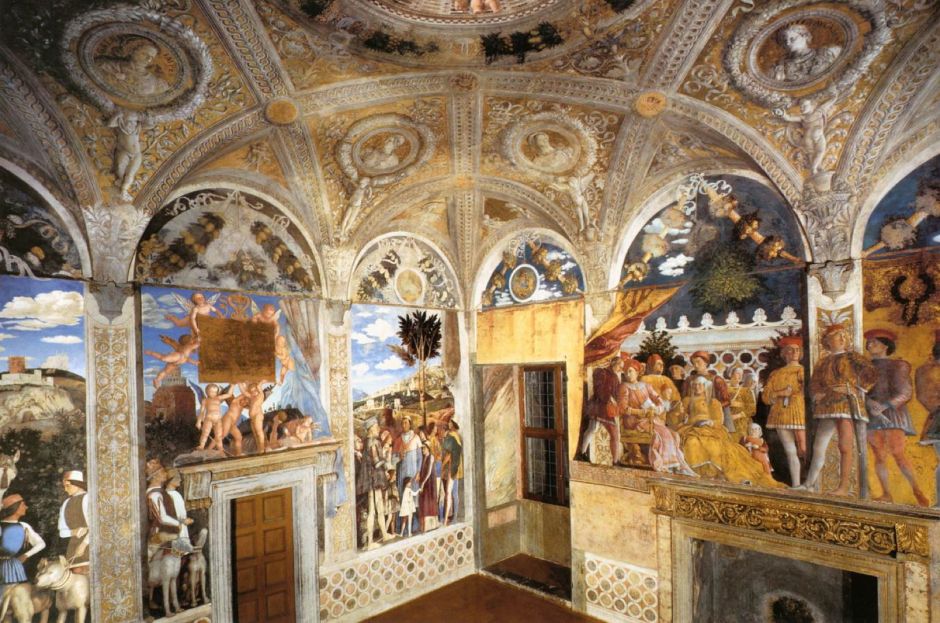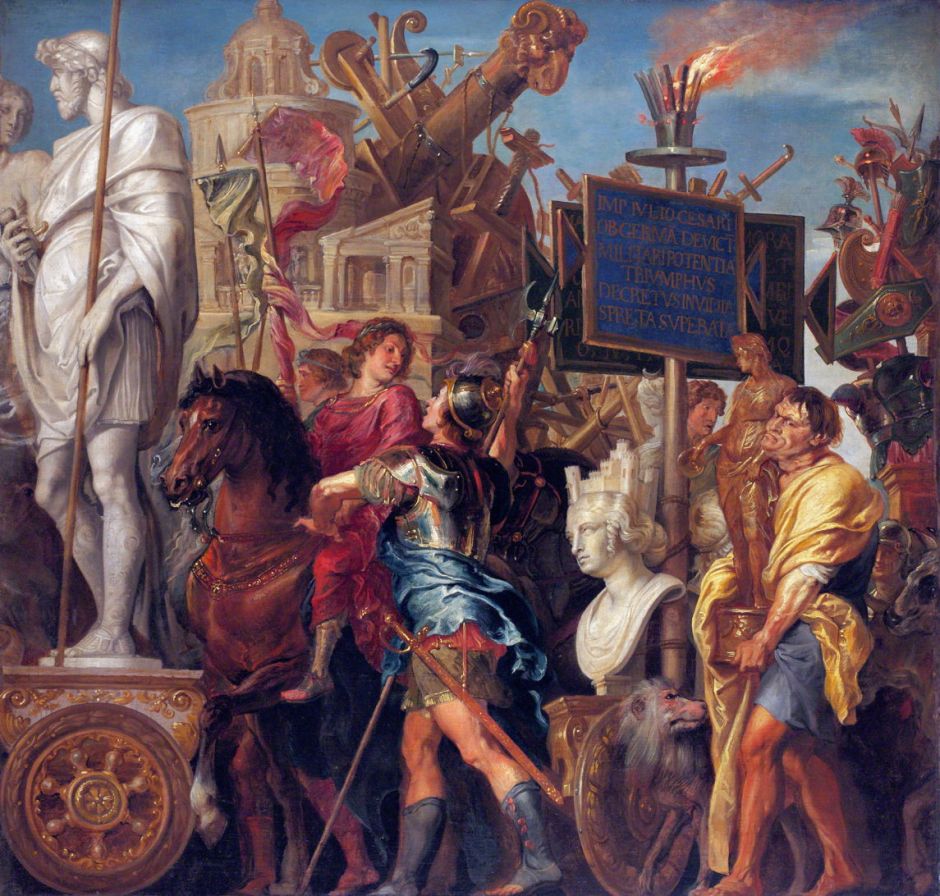The small city-state of Mantua in Northern Italy had been ruled by the Gonzaga family since the early fourteenth century. When the third of its rulers, Ludovico III Gonzaga (1412-1478), came to power in 1444, he was engaged in a series of allegiances to bring improving stability to his lands. This culminated in a Council summoned in 1459 by Pope Pius II, who wasn’t impressed with Mantua as its host city.
One step Ludovico did take was to import some culture into his court. He had been looking at the established artist Andrea Mantegna (1431–1506), who had already distinguished himself in his painting for the nearby court at Ferrara, and soon after the death of Pisanello in about 1455, Mantegna was approached and asked if he would be interested. But Mantegna was notoriously stubborn, and it wasn’t until April 1458 that Ludovico was able to make a formal offer, which the artist accepted.
Even then, Mantegna asked for a six month deferment, to allow him to finish work which had already been commissioned. Ludovico recognised that trying to pressure his new court painter would only result in greater delay, so told the artist to take as long as he needed to ensure that his mind was at rest. Mantegna did, and didn’t arrive in Mantua until the end of January 1459, and it wasn’t until the Spring of the following year that Mantegna finally moved his family to court. Ludovico had already learned that politics was more flexible than his new court painter.
Mantegna’s first task for Ludovico had already begun by then. His patron had used Mantegna’s specifications to build a new family chapel in the refurbished Castello di San Giorgio, for which Mantegna started producing panels in 1460. Although the building was destroyed in the sixteenth century, its greatest surviving painting is the triptych now in the Uffizi in Florence.

Probably painted between 1463-64, Mantegna’s Triptych is in his conservative style, which had changed little since he first became a master by around 1448. It is decidedly illusionistic, and his eye for detail captures history, geology and architecture which must have pleased his patron, who had enjoyed an advanced humanist education. At the same time, the artist was keen to please; earlier in Padua he had shocked when he showed only eight of the twelve apostles in a fresco. In the Ascension at the left, he has dutifully squeezed in the expected number. The centre panel, showing the adoration of the Magi, is curved to fit an altar niche, and the scene at the right shows the Circumcision.
As he was steadily making progress on the other panels for that chapel, Mantegna was given an even greater challenge, to decorate a small chamber on the first floor of the Castello, known now as the Camera degli Sposi “the bridal chamber” for Ludovico and his wife Barbara of Brandenburg, who had actually married in 1433. He completed the final dedicatory plaque to his patron in 1474.

The result is as startling as Raphael’s later rooms in the Vatican. No detail has been missed in Mantegna’s painting and decoration.

On one of the walls, Mantegna has painted his patron and his court. Obvious at the left is Ludovico III Gonzaga, talking to one of his staff. Barbara sits further towards the centre, with the youngest two of their children, another two older offspring are also present, and under Ludovico’s chair is his favourite dog Rubino.
But the truly breath-taking touch, and for me one of Mantegna’s greatest achievements, is in the room’s ceiling, which is actually flat rather than domed.

Ludovico is believed to have suffered from bouts of depression. What better to lift his spirits than this magnificent trompe l’oeil achieved by masterly use of foreshortening, rising up to his lapis-lazuli sky above?
A couple of years later, Mantegna’s frescoes nearly brought a diplomatic incident, when Duke Galeazzo Maria Sforza of Milan felt offended that he hadn’t been included in the portraits in what he thought was the most beautiful room in the world. Ludovico reassured the Duke that Mantegna’s portraits lacked grace – which certainly seems true of his depiction of Barbara.
Whatever Ludovico really though of Mantegna’s frescoes, it’s clear that this room was a vital asset to the ruler of Mantua. He seems to have shown it off to a great many other rulers and people of influence.
Then in 1478, Ludovico died of plague. Following his death, his oldest surviving son Federico succeeded to the marquisate, but at the cost of dividing its possessions with his brothers. Six years later, at the age of only 43, he too died, and was succeeded by Francesco II Gonzaga, who in 1490 married Isabella d’Este.
That wasn’t a happy or prosperous period for Mantegna, at least until about 1484 when he was given the task of painting a series of panels on The Triumphs of Caesar, and awarded a knighthood.

Sadly the surviving panels have lost much of their former glory, but this free copy made by Rubens and Erasmus Quellinus II gives a good idea of what they must have looked like. In 1488-90, Mantegna worked for Pope Innocent VIII painting frescoes in a chapel in the Belvedere in the Vatican, but they were destroyed three centuries later.

In 1495, Francesco Gonzaga won a costly and inconclusive victory over Charles VIII’s army at the Battle of Fornovo. He got Mantegna to commemorate that in Madonna della Vittoria (1495-96), set in an exotic pergola among fruits, flowers and birds in another brilliant illusion.
Shortly after that, Mantegna painted two works for Francesco’s wife Isabella d’Este and her studiolo, which I have already discussed in detail.
Mantegna arranged to be recommended to Isabella through her former tutor, but his first attempt to impress her with a portrait in 1493 met with a stony reception: Isabella declined it as being so badly painted that it didn’t resemble her. Perhaps his lifelong obstinacy had finally met its match.

Despite that discouraging start, her first commission for a painting for her study was awarded to Mantegna, for his Mars and Venus, known better as Parnassus (1496-97). She had apparently grown to like his finely-finished and rather old-fashioned tempera paintings, and the artist probably painted this largely in tempera, only for it to be repainted using oils after his death.

A couple of years later, Isabella returned to commission Mantegna to paint a more moralistic allegory of The Triumph of the Virtues, or Pallas Expelling the Vices from the Garden of Virtue (1499-1502), again largely in tempera.
Mantegna died in his mid-seventies in 1506, still living in Mantua, which had been at least partly responsible for some of his greatest work, and one of the finest trompes l’oeil in European painting.
References
Wikipedia.
Camera degli Sposi.
Isabella d’Este.
Alison Cole (2016) Italian Renaissance Courts: Art, Pleasure and Power, Laurence King, ISBN 978 1 78067 740 8.

